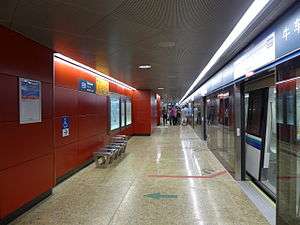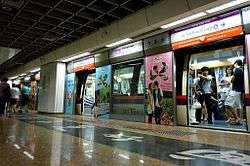Chinatown MRT Station
NE4 DT19 Chinatown 牛车水 சைனாடவுன் Chinatown | |||||||||||||||||||||
|---|---|---|---|---|---|---|---|---|---|---|---|---|---|---|---|---|---|---|---|---|---|
| Rapid transit | |||||||||||||||||||||
 Downtown Line platform of Chinatown MRT station. | |||||||||||||||||||||
| Location |
151 New Bridge Road 91 Upper Cross Street Singapore 059443/058362 | ||||||||||||||||||||
| Coordinates | 1°17′05″N 103°50′38″E / 1.28485°N 103.844006°E | ||||||||||||||||||||
| Operated by |
SBS Transit (ComfortDelGro) (North East Line) SBS Transit DTL (Downtown Line) | ||||||||||||||||||||
| Line(s) | |||||||||||||||||||||
| Platforms |
Island (North East Line) Side (Downtown Line) | ||||||||||||||||||||
| Tracks | 4 | ||||||||||||||||||||
| Connections | Bus, Taxi | ||||||||||||||||||||
| Construction | |||||||||||||||||||||
| Structure type | Underground | ||||||||||||||||||||
| Platform levels | 3 | ||||||||||||||||||||
| Parking | Yes | ||||||||||||||||||||
| Bicycle facilities | Yes | ||||||||||||||||||||
| Disabled access | Yes | ||||||||||||||||||||
| Other information | |||||||||||||||||||||
| Station code | NE4 DT19 | ||||||||||||||||||||
| Fare zone | 1 | ||||||||||||||||||||
| History | |||||||||||||||||||||
| Opened |
20 June 2003 (North East Line) 22 December 2013 (Downtown Line) | ||||||||||||||||||||
| Electrified | Yes | ||||||||||||||||||||
| Previous names | People's Park | ||||||||||||||||||||
| Services | |||||||||||||||||||||
| |||||||||||||||||||||
| Location | |||||||||||||||||||||
 | |||||||||||||||||||||


Chinatown MRT Station (NE4/DT19) is a Mass Rapid Transit (MRT) interchange station on the North East Line and the Downtown Line in Outram, Singapore. On the North East Line, it lies between the Outram Park and Clarke Quay MRT stations and between Telok Ayer and Fort Canning MRT stations on the Downtown Line. It is directly below and serves the ethnic district of Chinatown. The construction of the station was considered an engineering achievement, due to the busy traffic on the roads above and a number of nearby historical buildings that had to be preserved during the construction. The section of track between Telok Ayer and this station is the shortest between any two stations on the MRT network; it takes around 35 to 40 seconds for a train to travel between the stations.
This station serves as the southern terminus of the Downtown Line from 22 December 2013 till 2017, where it would be replaced by Expo as the third stage of the line opens.
Art in Transit
North East Line
There are Chinese calligraphy paintings in the station titled, "The Phoenix’s-Eye Domain" telling the significance of Chinatown. It is painted by renowned Singapore artist Tan Swie Hian.[1]
Downtown Line
Artwork titled, "Flying Colours" by Cheo Chai Hiang illustrate hanging clothes on poles outside windows, delivering the illusion towards commuters passing by that the clothes are flying in the wind.[2]

History
The North East Line part of this station was first constructed and opened on 20 June 2003. It is also called People's Park MRT Station. It is sited below Eu Tong Sen Street and New Bridge Road. Provisions were made during the construction for Downtown MRT Line, where it was upgraded in January 2010.
The Downtown Line part of this station commenced on 12 February 2008 and opened on 22 December 2013, as part of the six-station Stage 1 of the Downtown Line. It is also called Hong Lim MRT Station. The Downtown Line station and tracks are built beneath Cross Street, above and perpendicular to the North-East Line station and tracks. Construction of the Downtown Line station also added a new entrance near Hong Lim Complex which enhances the connectivity to Hong Lim Complex instead of taking the MRT to Raffles Place and struggling with a walk.[3]
Before the North-East Line part of this station opened, the Singapore Civil Defence Force conducted the second ever Shelter Open House on 15–16 February 2003, together with Farrer Park, Serangoon and Hougang stations.
Construction
This station is said to be the most challenging station to build on the North-East line, due to the large number of buildings above ground, most with reinforced concrete or timber piles and all in marine clay.[4] Another feat was that they had to preserve Garden Bridge, a large overhead bridge on bore piles, while building the station below. The tidal Eu Tong Sen Canal was also diverted into four two-meter diameter steel pipes slung under the temporary traffic decks (two on each side). Rigorous safety precautions ensured there were no fatal accidents during the construction.
Station layout
The main entrance and exit of the station is situated in the middle of Pagoda Street within the heart of Chinatown, which is now closed to all automobiles but remains open to pedestrians and manual vehicles such as trishaws. One could note that the modern architecture of the station entrance could provide an uneasy contrast to the Victorian era shophouses surrounding it, although some like the cultural fusion between the two different architectures.
| L1 | Street Level | |
| B1 | ||
| DTL Concourse | Faregates, Ticketing Machines, Passenger Service Centre | |
| B2 | ||
| NEL & DTL Concourse | Faregates, Ticketing Machines, Passenger Service Centre | |
| Side platform, No Train Service at this Platform | ||
| Platform D | Downtown Line Westbound towards DT1 BP6 Bukit Panjang via DT18 Telok Ayer (←) | |
| Platform C | Downtown Line Westbound towards DT1 BP6 Bukit Panjang via DT18 Telok Ayer (←) | |
| Side platform, doors will open on the left | ||
| B3 | Platform A | North East Line Southbound towards NE1 CC29 HarbourFront via NE3 EW16 TE17 Outram Park (→) |
| Island platform, doors will open on the right | ||
| Platform B | North East Line Northbound towards NE17 PTC Punggol via NE5 Clarke Quay (←) | |
| Transfer Linkway | Paid link to Downtown Line Platform C | |
Exits
- A: Chinatown Complex (Market & Food Centre)
- C: People's Park Complex
- D: People's Park Centre
- E: Hong Lim Park
- F: Fook Hai Building, Hong Lim Complex
- G: Chinatown Point, Hong Lim Complex
Transport connections
Rail
| Destination | First Train | Last Train | |||||
|---|---|---|---|---|---|---|---|
| Mon - Fri | Sat | Sunday & Public Holiday | Daily | ||||
| North East Line | |||||||
| to NE1 HarbourFront | 6.10am | 6.11am | 6.32am | 11.55pm | |||
| to NE17 Punggol | 5.50am | 6.05am | 6.25am | 12.00am | |||
| Downtown Line | |||||||
| to DT1 Bukit Panjang | 6.10am | 6.10am | 6.28am | 12.10am | |||
Gallery
| Wikimedia Commons has media related to Chinatown MRT Station. |
-
The entrance to Chinatown station at street level, which lies in the middle of Pagoda Street in the heart of Chinatown which is now closed to automobile traffic
-

An illustration, inspired by Chinatown MRT, particularly by Pagoda Street in Singapore
-

Chinatown MRT Station Exit E.
-

Escalators to Platform C (Downtown Line) of Chinatown MRT
-

Downtown Line label in Chinatown Station's Downtown Line in Singapore
References
- ↑ "NE4 - Chinatown". SBS Transit. Retrieved 16 October 2013.
- ↑ "Downtown Line 1: Art-In-Transit" (PDF). Land Transport Authority. Retrieved 16 October 2013.
- ↑ "Chinatown Station". Land Transport Authority. Retrieved 2008-04-07.
- ↑ Other Rail Projects - North East Line, Land Transport Authority